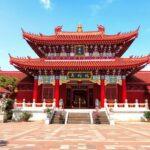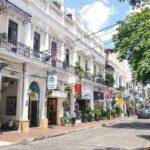Table of Contents
ToggleThang Long Imperial Citadel
At the center of Vietnam’s capital lies a site that witnessed centuries of dynastic rule, colonial resistance, and national resilience — the Thang Long Imperial Citadel. Recognized by UNESCO in 2010 as a World Heritage Site, this vast historical complex preserves the heart of ancient Hanoi and the evolution of Vietnamese civilization. For golf travelers teeing off at Van Tri Golf Club, Sky Lake, or Long Bien Golf Course, Thang Long Citadel offers an enriching half-day city break — where you trade scorecards for scrolls and fairways for flag towers.
Historical Significance
Thang Long, meaning “Ascending Dragon,” was established by Emperor Ly Thai To in 1010 AD after he reportedly saw a dragon rising over the Red River — a divine omen. The Ly Dynasty made Thang Long the capital of Đại Việt, and it remained the political, economic, and cultural heart of Vietnam for nearly 800 years. The citadel served as the seat of power for the Ly, Tran, and Le dynasties. Under each, new palaces, temples, and administrative buildings were constructed. Though many of the original structures were lost due to wars and time, the foundations and preserved remnants continue to reflect Vietnam’s dynastic evolution, Buddhist philosophy, and Confucian order.
Top Highlights Within the Citadel
- Flag Tower of Hanoi: A 33-meter tall structure from the early 19th century, one of the few citadel features left intact during French colonial rule
- Doan Mon Gate: The main southern gate once used for royal processions
- Kinh Thien Palace Site: Marked by large stone steps and dragon carvings — the former center of royal ceremonies
- D67 Command Bunker: A preserved wartime headquarters used by General Giap during the Vietnam War
- 18 Hoang Dieu Archaeological Site: Displays layers of artifacts from ancient Chinese rule through to the Nguyen dynasty
Architectural Features
The layout of Thang Long reflects classic Eastern feng shui — aligned along a north-south axis, with the Red River at its back and the mountains in the distance. The citadel was designed to mirror heaven and earth, a theme reinforced by dragon motifs, lotus ponds, and tiered stone foundations. The blend of dynastic and modern wartime structures makes it a rare site that spans over 1,300 years of continuous political activity.
Getting There from Hanoi Golf Courses
- From Van Tri Golf Club: ~25–30 minutes by car
- From Long Bien Golf Course: ~20–25 minutes
- From Sky Lake: ~45–50 minutes
The citadel is centrally located in Ba Dinh District — near major museums, the Presidential Palace, and Hoan Kiem Lake. Combine your visit with cultural stops or a food walk through the Old Quarter.
Best Time to Visit
The site is open Tuesday through Sunday from 8:00 AM to 5:00 PM. Spring (March–April) and autumn (October–November) are ideal, with cooler temperatures and lower humidity. Arrive in the morning for the best light and fewer crowds.
Where to Stay
Choose accommodations in Hanoi’s Ba Dinh or Hoan Kiem districts for proximity to the citadel and ease of transport to golf courses. Book through:
Suggested Golf & Culture Itinerary
- Morning: Golf at Van Tri or Long Bien
- Midday: Traditional Hanoi lunch near Hoan Kiem
- Afternoon: Tour Thang Long Citadel and 18 Hoang Dieu archaeology site
- Evening: Watch a water puppet show or dine at a rooftop terrace overlooking the Old Quarter
Tips for Golf Travelers
- Wear sun protection and bring water — much of the complex is exposed
- Engage a licensed guide for a deeper understanding of the dynasties and symbolism
- Buy a combo ticket that includes nearby museums and historic sites
Why It Resonates with Golf Travelers
Golf rewards patience, tradition, and precision — so does history. Thang Long’s layout, symmetry, and symbolism mirror the mindset of a thoughtful player. As you walk from flag tower to dragon stairway, the story of Vietnam’s past unfolds like a well-paced round — strategic, reflective, and rich with meaning.
Final Thoughts
Thang Long Imperial Citadel is more than an archaeological site — it’s the backbone of a nation. For golf travelers, it bridges the competitive joy of the course with the contemplative beauty of heritage. Come for the fairways, stay for the stories, and leave with a deeper sense of place that no scorecard can capture. Continue exploring more Places of Interest in Vietnam and enrich your journey with the culture, history, and heart behind every destination.
Useful Golf Resources in Vietnam
Travel Visas & Entry Tips (VisaHQ)
Check visa requirements and entry rules by country. VisaHQ makes it easy for golfers to plan ahead and avoid border delays.
Golf Travel Insurance (World Nomads)
Protect your gear and your trip with insurance designed for active travelers. Coverage includes golf equipment, medical, and trip interruptions.








